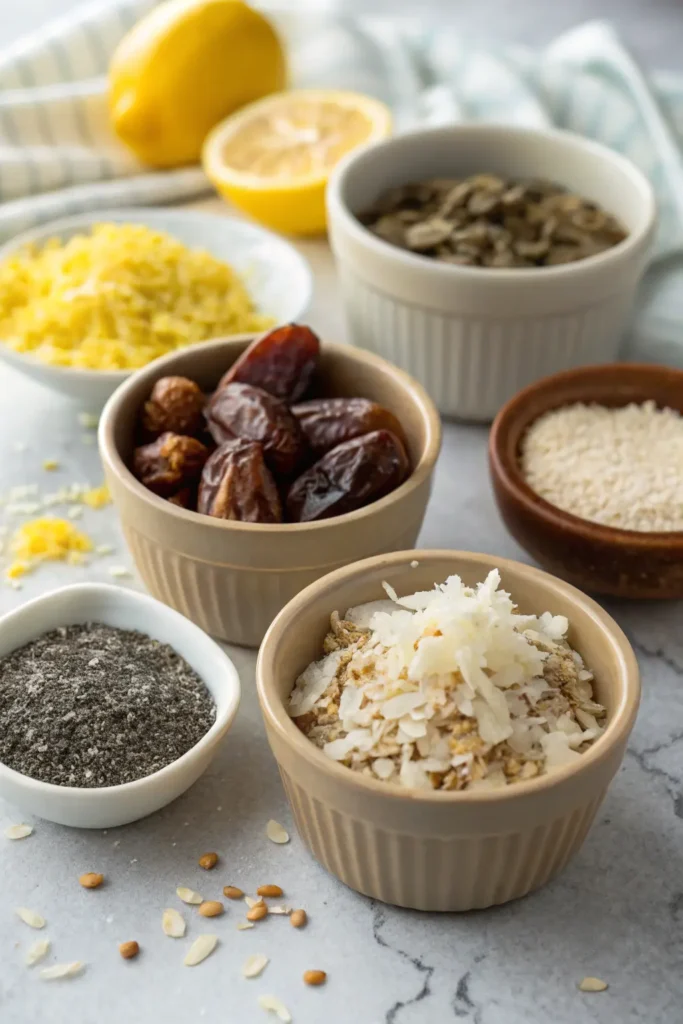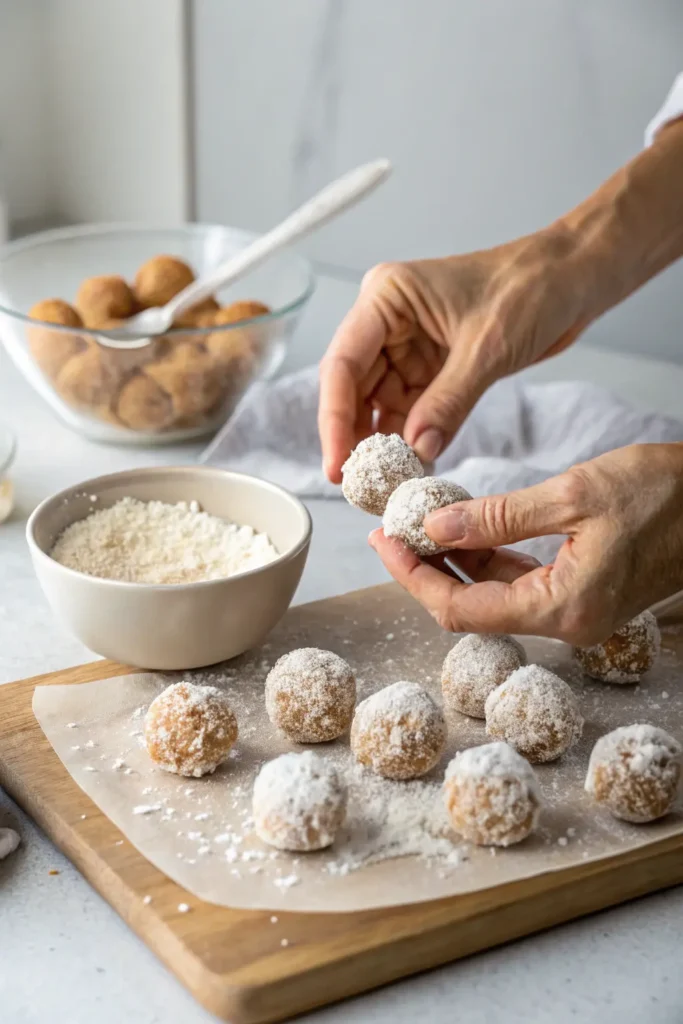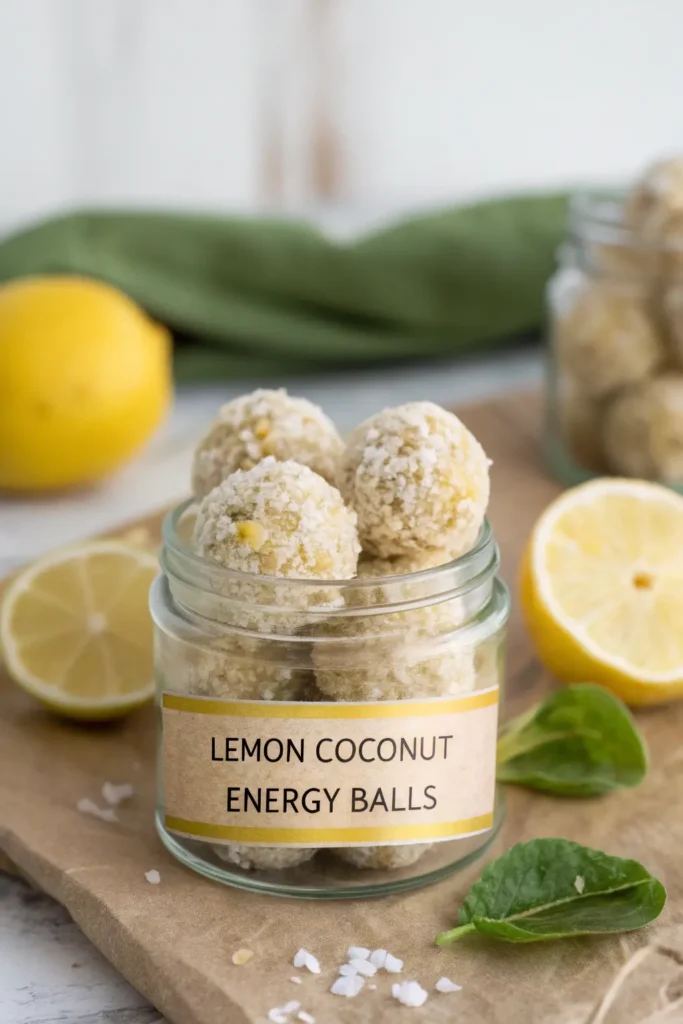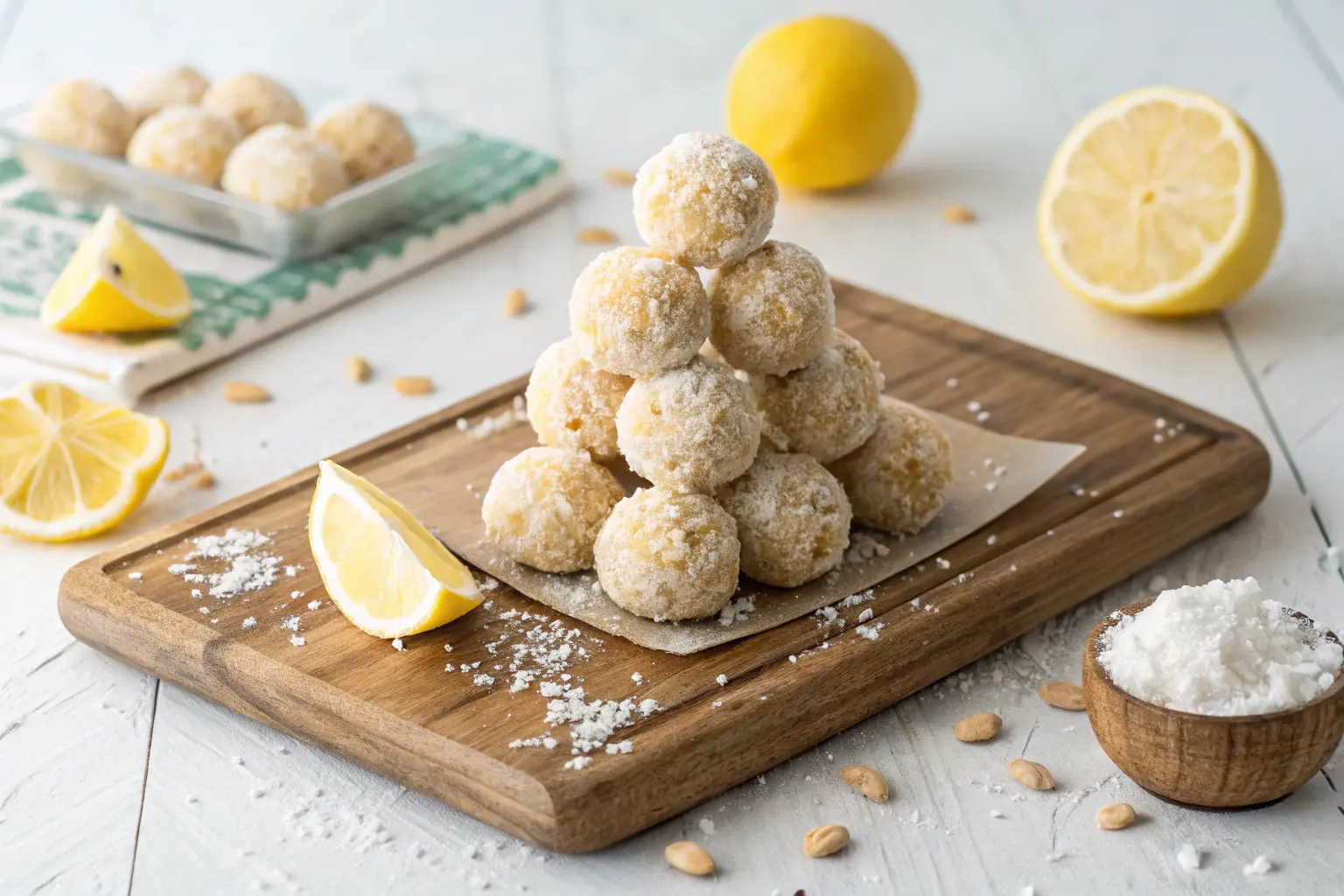Looking for a wholesome, zesty treat you can whip up in minutes? Lemon Coconut Energy Balls might just become your new go-to. These little bursts of citrusy delight are more than just pretty snacks—they’re packed with nutrients, easy to make, and absolutely no-bake. This article takes a deep dive into everything you need to know about these gluten-free lemon bites, from their health perks to recipe variations and smart prep tips.
Discover with us this easy and delicious recipe: Dubai Chocolate
We’ll walk you through the ingredients, step-by-step instructions, and even some helpful do’s and don’ts to get the perfect texture and flavor. If you’re curious about how to enjoy them, store them, or even swap ingredients to match your diet, we’ve got you covered. Stick around—by the end, you’ll not only know how to make lemon coconut energy balls, but also why they’re one of the smartest snacks around.
What Are Lemon Coconut Energy Balls?
What exactly are energy balls?
Energy balls, sometimes called bliss balls or energy bites, are small, bite-sized snacks made primarily with whole, nutrient-dense ingredients. They’re usually packed with nuts, seeds, dried fruits, oats, and natural sweeteners. The best part? They don’t need baking.
In the case of lemon coconut energy balls, that clean list of ingredients gets an exciting citrus twist. The lemon adds brightness and zest, while the coconut brings a creamy, slightly sweet flavor that balances everything out. Think of them as nature’s version of candy—with a purpose.
Why lemon and coconut are the dream duo
There’s something magical about pairing zesty lemon with rich coconut. This combination doesn’t just taste amazing—it also serves up a one-two punch of nutrition. Lemons are full of vitamin C and antioxidants, which support your immune system and help reduce inflammation. Coconut, on the other hand, contains healthy fats and fiber, helping keep you full and satisfied longer.
These two flavors complement each other perfectly: lemon cuts through the richness of coconut, while coconut tones down the sharp citrus notes. It’s a flavor match made in snack heaven.
The rise of lemon coconut energy balls
With the growing popularity of clean eating and no-bake recipes, these citrusy treats have carved out a spot on countless meal prep lists. They’re ideal for anyone living a vegan, paleo, gluten-free, or dairy-free lifestyle. Plus, they travel well—so whether you’re hiking, hustling at work, or handling toddler snack duty, lemon coconut energy balls have your back.
Discover with us this easy and delicious recipe: recipesfreesh
Health Benefits of Lemon Coconut Energy Balls
Nutritional breakdown of key ingredients
Lemon Coconut Energy Balls might taste like a treat, but they’re built on powerful, nutrient-dense ingredients. What makes them even more appealing is that they’re packed with natural energy sources, which means you get sustained fuel without a crash.
Let’s start with dates, a common base in these bites. They’re naturally sweet, loaded with fiber, and give your body quick, clean energy. Add in oats or nuts like cashews, and you’re getting healthy fats and protein that help stabilize blood sugar.
Lemons: A citrus powerhouse
Lemons aren’t just there for the flavor—they bring some serious health perks. High in vitamin C, they boost your immune system and can even improve skin health. Their natural acidity also helps with digestion, making these citrus energy balls ideal for a midday snack that won’t weigh you down.
Coconut: Creamy, fibrous, and full of good fats
Coconut is often overlooked, but it’s a snack-time hero. It’s rich in medium-chain triglycerides (MCTs)—a type of fat your body can use quickly for energy. Plus, coconut adds fiber and a satisfying texture to these bites. When combined with lemon, the result is a fresh, tropical flavor that doesn’t compromise nutrition.
Energy-boosting properties
While many store-bought snacks are full of empty calories, lemon coconut energy bites deliver lasting energy, thanks to their clean list of ingredients. Whether you’re powering through meetings, school pickups, or your next hike, these bites won’t let you down.
Natural sugars and plant protein in action
Thanks to dates, oats, and seeds, each bite gives you a combo of carbs and protein. That’s key for sustained energy release—no sugar crashes here. Chia seeds or protein powder, often added to variations of these no-bake lemon snacks, take things up a notch.
Clean-eating friendly
Here’s the bonus: these lemon coconut bliss balls are usually vegan, dairy-free, and gluten-free. That makes them easy to fit into nearly any diet, even if you’re managing allergies or following a specific lifestyle like paleo or whole foods plant-based.
Ingredients Needed for Lemon Coconut Energy Balls

Core ingredients and optional add-ins
The best part about making lemon coconut energy balls at home? You don’t need fancy tools or hard-to-find items. Most recipes use simple pantry staples you likely already have.
A typical recipe includes:
- Dates – for sweetness and stickiness
- Shredded coconut – for flavor and texture
- Lemon zest and juice – for that zing
- Oats or nuts (like almonds or cashews) – for bulk and nutrients
- Chia seeds or flaxseeds – optional, for extra fiber and protein
Boosting flavor with simple extras
You can always tweak the basic recipe to suit your taste. Adding a splash of vanilla extract or a pinch of sea salt can take these vegan lemon coconut bites to another level.
Want a more indulgent version? Add a few white chocolate chips. Craving something extra zesty? Increase the lemon zest or squeeze in a touch more juice.
Ingredient substitutions for dietary needs
One of the biggest perks of lemon coconut energy balls is how flexible they are. Whether you’re avoiding nuts, cutting carbs, or sticking to a keto diet, there are easy swaps you can make.
Nut-free, low-carb, or keto versions
- Nut-Free: Swap almonds or cashews for sunflower seeds or pumpkin seeds.
- Low-Carb/Keto: Use unsweetened shredded coconut, almond flour, and a low-carb sweetener like monk fruit instead of dates.
- High-Protein: Add plant-based protein powder or nut butter to boost muscle-repairing nutrients.
With just a few changes, these healthy citrus energy balls can fit your personal nutrition plan—no compromise needed.
How to Make Lemon Coconut Energy Balls – Step-by-Step Guide

Prep tips for perfect texture and flavor
Before you dive into making lemon coconut energy balls, a little prep goes a long way. For the best texture, you’ll want your ingredients soft, fresh, and ready to blend.
Soaking dates for smooth blending
If your dates are a bit dry or tough, soak them in warm water for about 10 minutes. This softens them up and makes them blend easier, which helps you get that ideal sticky consistency without overworking your food processor.
Using the right tools
While you don’t need a high-end blender, a reliable food processor makes the job quicker. It ensures all ingredients are chopped and combined evenly—no big chunks or uneven bites.
Easy mixing and rolling instructions
Making lemon coconut energy balls is all about simplicity. Once you’ve prepped your ingredients, the rest comes together fast.
- Add your base ingredients—like dates, oats, and coconut—to the food processor.
- Pulse a few times until the mixture looks crumbly.
- Add lemon juice and zest for that punch of flavor.
- Mix until sticky and uniform—the mixture should hold when pressed.
- Roll into bite-sized balls, about 1 inch in size.
- Optional: Roll each ball in extra shredded coconut for a prettier finish and added texture.
Time-saving tips for batch prep
If you’re short on time, scoop the mixture using a small cookie dough scoop. It gives you even portions without the mess. You can also double the recipe and freeze half—it’s a smart way to stay stocked with healthy no-bake lemon snacks.
Storage and shelf life
Keeping your lemon coconut energy balls fresh is simple. Store them in an airtight container in the fridge for up to one week. For longer storage, freeze them—they’ll last a month or more and only need a few minutes to thaw.
Freezing tips and snack prep advice
Lay them on a baking sheet to freeze first, then move them to a container. This prevents them from sticking together. Grab a few in the morning, and by lunch, they’re ready to eat!
Recipe Variations of Lemon Coconut Energy Balls
Lemon Coconut Chia Balls
Want an easy upgrade? Add chia seeds to the mix. These tiny seeds pack a punch with omega-3s, fiber, and protein. They also add a slight crunch, which many people love. Just toss in a tablespoon or two during mixing.
Benefits of adding chia seeds
Chia seeds help with digestion, heart health, and even hydration. They absorb liquid, so your energy balls may firm up a bit more—great if you like a denser bite.
Lemon Coconut Protein Balls
For a post-gym snack or an afternoon boost, add a scoop of vanilla or unflavored protein powder to your base mix. Not only does this increase the protein content, but it also gives the balls a fluffier texture.
Post-workout snack twist
The blend of natural sugars from dates and added protein makes this version ideal after workouts. It helps with muscle recovery and keeps you full longer, making them a smart alternative to sugary bars.
Kid-friendly Lemon Coconut Balls
Kids love snacks they can grab and eat easily, and these no-bake lemon coconut balls fit the bill. Just leave out seeds and protein powders for a smoother texture, and use fewer ingredients to keep the flavor simple.
Making them with fewer ingredients
A great 4-ingredient version: dates, coconut, oats, and lemon. That’s it! These are mild enough for toddlers but tasty enough for older kids—and adults, too.
When and How to Enjoy Lemon Coconut Energy Balls

The perfect times to snack on Lemon Coconut Energy Balls
There’s really no wrong time to enjoy lemon coconut energy balls—that’s what makes them so versatile. Whether you’re trying to power through the afternoon slump or need a quick pre-workout bite, these little snacks fit right into your day.
They’re great in the morning with coffee, excellent as a midday pick-me-up, and even work as a light dessert after dinner. Plus, they’re mess-free and portable, making them ideal for lunchboxes, road trips, or office drawers.
Best serving sizes and timing
Most recipes yield balls about 1 inch in diameter. One to two balls per serving is usually enough to curb cravings without overdoing it. If you’re eating them before exercise, aim for 30 minutes ahead of your workout. That way, the natural sugars and healthy fats have time to kick in.
Delicious pairings and creative serving ideas
Want to elevate your snack game? Try pairing lemon coconut energy bites with herbal teas like chamomile or green tea. Their zesty flavor also complements smoothies, especially those with banana, spinach, or berries.
Fun ways to serve them
- Stack them on a platter with fresh lemon slices for a party tray
- Serve with coconut yogurt for a fiber-rich snack
- Pack them in a mason jar for an on-the-go treat that looks as good as it tastes
You can even crumble them over oatmeal or chia pudding for a citrusy topping. However you choose to enjoy them, they’re bound to add brightness to your routine.
Common Mistakes to Avoid When Making Lemon Coconut Energy Balls
Over-processing the mixture
A common issue when making lemon coconut energy balls is blending the ingredients too long. Sure, you want a uniform mix, but if you go too far, the oils from the nuts and coconut start to separate. This makes the dough greasy and harder to work with.
Tips for keeping the right texture
Pulse the mixture instead of running the processor nonstop. Stop and check often—when it starts clumping together and holds its shape when pressed, you’re ready to roll.
Using too much or too little liquid
Lemon juice adds flavor, but it also changes the texture. Add too much, and the mix becomes too wet to roll. Use too little, and the balls might be dry or crumbly.
How to fix sticky or dry energy balls
If your batch is too sticky, add more oats or coconut flakes a tablespoon at a time. If it’s too dry, try another splash of lemon juice or a small spoon of nut butter. You could even toss in a couple more soaked dates to bind the mixture better.
Best Tools and Equipment for Making Energy Balls at Home
Essential tools to simplify the process
Making lemon coconut energy balls is pretty straightforward, but using the right tools can take your prep from stressful to seamless. These aren’t fancy or expensive—just smart additions to your kitchen that save time and effort.
Food processor: The MVP
A food processor is hands-down the best tool for making energy balls. It crushes dates, oats, coconut, and nuts into a fine, sticky mixture in under a minute. Compared to hand-mixing or using a blender, it’s faster and more consistent.
- Tip: Choose a processor with a strong motor (600W+), especially if you’re using tough dried fruits like dates or figs.
Helpful extras for shaping and storing
Once your mix is ready, shaping the perfect no-bake lemon coconut bites becomes the next step. While you can always use your hands, there are tools that make the job easier (and cleaner).
Scoopers and rolling tools
- Mini cookie scoop – For even portion sizes
- Silicone gloves – Prevent sticking and keep things sanitary
- Small bowl of water – Wet your hands lightly before rolling to keep the mixture from sticking
Storing your lemon coconut energy balls
Proper storage ensures your bites stay fresh and flavorful. Airtight containers are a must.
Best storage solutions
- Glass food containers – Durable and leak-proof
- Stackable BPA-free plastic bins – Great for small spaces
- Silicone snack bags – Reusable, eco-friendly, and ideal for travel
For longer shelf life, store your lemon coconut bliss balls in the freezer using parchment paper between layers to prevent sticking.
FAQs About Lemon Coconut Energy Balls
How long do lemon coconut energy balls last?
Typically, they last up to 7 days in the fridge and 30 days in the freezer. Always store them in an airtight container to keep them fresh and moist. If they dry out, just roll them in a bit of lemon juice and shredded coconut to bring them back to life.
Can I freeze lemon coconut energy balls?
Yes! In fact, freezing is ideal if you want to batch-prep. Lay them flat on a baking sheet to flash-freeze, then transfer to a sealed bag or container. Take out a few at a time and let them thaw for 10–15 minutes before eating.
Are lemon coconut energy balls suitable for kids?
Absolutely. They’re sweet, soft, and fun to eat—perfect for little hands. Just be mindful of ingredients like nuts or seeds if your child has allergies. For toddlers, go with a simpler version: dates, oats, coconut, and lemon.
What’s the best sweetener to use?
Most recipes use Medjool dates for natural sweetness. If you want a different option, try maple syrup, honey, or a low-glycemic sweetener like monk fruit. Keep in mind that dates also help bind the mix, so if you replace them, adjust the texture with oats or coconut flour.
Can I make them without a food processor?
You can, but it’ll take more effort. Soak your dates and mash them with a fork or potato masher. Finely chop your other ingredients and mix everything by hand. It’s doable, but be prepared to put in a little elbow grease.
How many calories are in one lemon coconut energy ball?
That depends on your ingredients and size. On average, each ball contains 80 to 120 calories. You can adjust this by using lighter ingredients or making smaller portions.
Conclusion:
When it comes to snack time, few things check all the boxes quite like lemon coconut energy balls. They’re nutritious, flavorful, portable, and ridiculously easy to make. Whether you’re looking for a guilt-free treat, an energy booster, or something wholesome for the kids, these no-bake lemon coconut bites have you covered.
Not only do they fit into just about any diet—vegan, gluten-free, dairy-free—but they also offer powerful health benefits thanks to ingredients like lemons, coconut, and oats. You can make them your own with endless variations, and they’re ideal for busy lifestyles.
If you haven’t tried making your own yet, now’s the perfect time. Stock your fridge (or freezer) and snack smart all week long.

